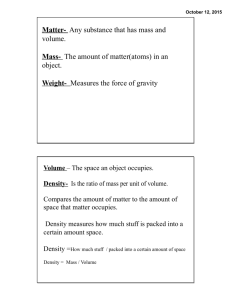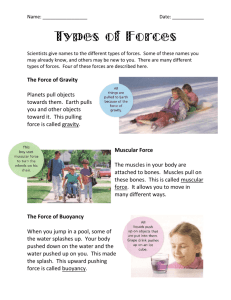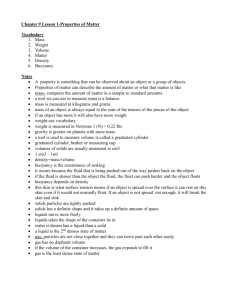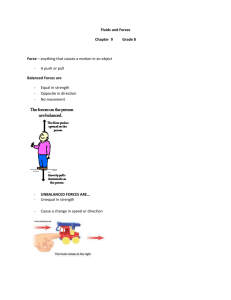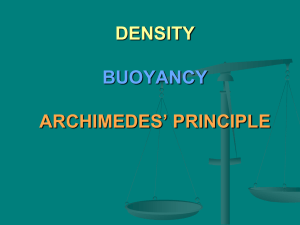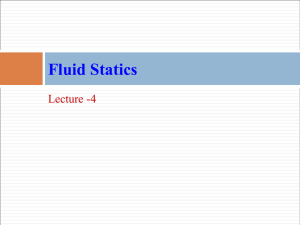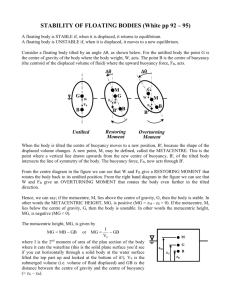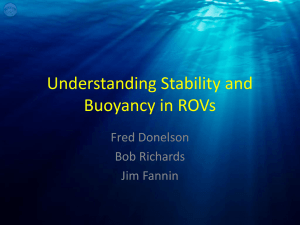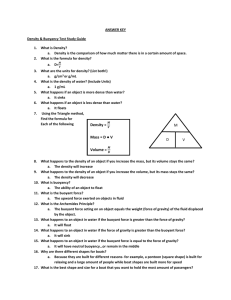Experiment No.3Metacentric Height
advertisement
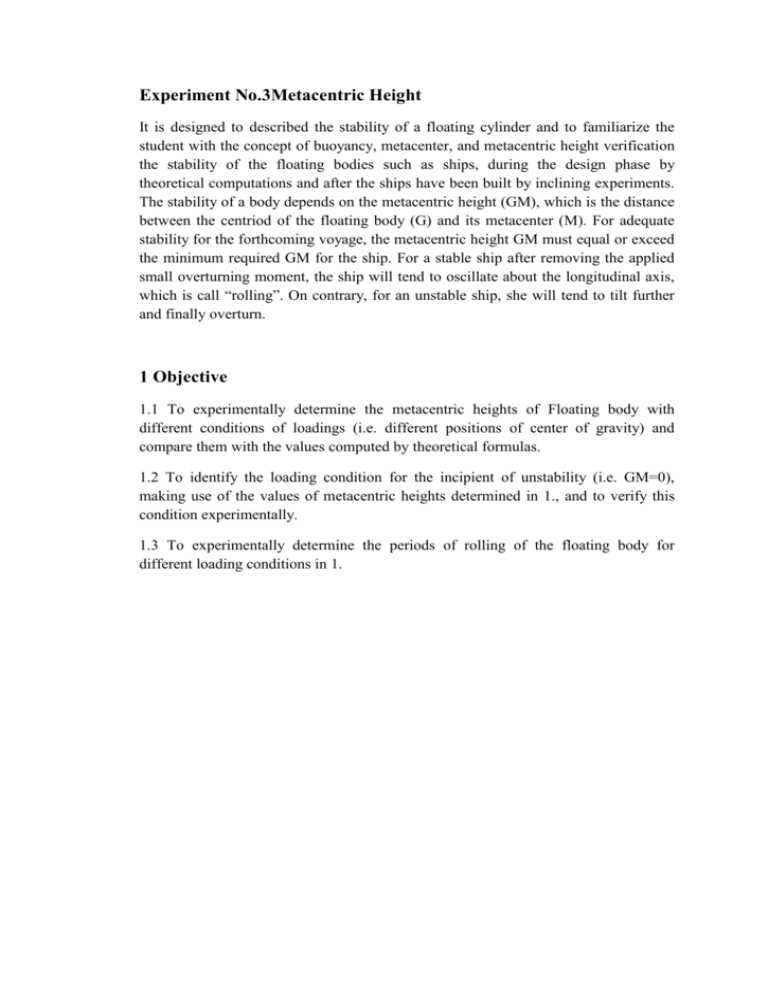
Experiment No.3Metacentric Height It is designed to described the stability of a floating cylinder and to familiarize the student with the concept of buoyancy, metacenter, and metacentric height verification the stability of the floating bodies such as ships, during the design phase by theoretical computations and after the ships have been built by inclining experiments. The stability of a body depends on the metacentric height (GM), which is the distance between the centriod of the floating body (G) and its metacenter (M). For adequate stability for the forthcoming voyage, the metacentric height GM must equal or exceed the minimum required GM for the ship. For a stable ship after removing the applied small overturning moment, the ship will tend to oscillate about the longitudinal axis, which is call “rolling”. On contrary, for an unstable ship, she will tend to tilt further and finally overturn. 1 Objective 1.1 To experimentally determine the metacentric heights of Floating body with different conditions of loadings (i.e. different positions of center of gravity) and compare them with the values computed by theoretical formulas. 1.2 To identify the loading condition for the incipient of unstability (i.e. GM=0), making use of the values of metacentric heights determined in 1., and to verify this condition experimentally. 1.3 To experimentally determine the periods of rolling of the floating body for different loading conditions in 1. 2 Experiment Apparatus The experimental setup consists of a water tank for floating the experimental boat. The boat is provided with a weight on a central mast. The position of C.G. can be located by means of a knife edge assembly. The size of boat can be measured by a ruler and a vernier caliper. Figure1 Vernier caliper Figure3 Boat Figure2 Ruler Figure4 Water tank Figure5 Electric balance 3 Theory The determination of metacentric height is important while investigating the stability of the floating bodies such as ships, during the design phase by theoretical computations and after the ship have been built by inclining experiments. 3.1 Archimedes’ principle Mechanical equilibrium takes a slightly different form than global hydrostatic equilibrium when a body of another material is immersed in a fluid. If its material is incompressible, the body retains its shape and displaces an amount of fluid with exactly the same volume. If the body is compressible, like a rubber ball, the volume of displaced fluid will be smaller. The body may even take in fluid, like a sponge or the piece of bread you dunk into your coffee, but we shall disregard this possibility in the following. A body which is partially immersed with a piece inside and another outside the fluid may formally be viewed as a body that is fully immersed in a fluid with properties that vary from place to place. This also covers the case where part of the body is in vacuum which may be thought of as a fluid with vanishing density and pressure. 3.2 Weight and buoyancy Let the actual, perhaps compressed, volume of the immersed body be V with surface S. In the field of gravity an unrestrained body with mass density body is subject to two forces: its weight FG body gdV (1) V and the buoyancy due to pressure acting on its surface, FB pdS (2) S If the total force F = FG + FB does not vanish, an unrestrained body will accelerate in the direction of F according to Newton’s Second Law. Therefore, in mechanical equilibrium weight and buoyancy must precisely cancel each other at all times to guarantee that the body will remain in place. Assuming that the body does not itself contribute to the field of gravity, the local balance of forces in the fluid will be the same as before the body was placed in the fluid. In particular the pressure in the fluid cannot depend on whether the volume V contains material that is different from the fluid itself. The pressure acting on the surface of the immersed body must for this reason be identical to the pressure on a body of fluid of the same shape, for any volume of fluid tells us that fluid, or FB FGFluid fluid gdV V (3) F FG FB ( body Fluid ) gdV (4) V explicitly confirming that when the body is made from the same fluid as its surroundings so that p body = p fluid the resultant force vanishes automatically. In general, however, the distributions of mass in the body and in the displaced fluid will be different. 3.3 Constant field of gravity In a constant gravitational field, g(x) = g(0), everything simplifies. The weight of the body and the buoyancy force become instead, FG M body g 0 , FB M fluid g 0 (5) Since the total force is the sum of these contributions, one might say that buoyancy acts as if the displacement were filled with fluid of negative mass. In effect the buoyancy force acts as a kind of antigravity. The total force on an unrestrained object is now, F FG FB ( M body M fluid ) g 0 (6) If the body mass is smaller than the mass of the displaced fluid, the total force is directed upwards, and the body will begin to rise, and conversely if the force is directed downwards it will sink. Alternatively, if the body is kept in place, the restraints must deliver a force. In constant gravity, a body can only hover motionlessly inside a fluid (or on its surface) if its mass equals the mass of the displaced fluid. M body M fluid (7) 3.4 Stability of floating bodies a) Equilibrium condition b) Disturbed condition Figure6 Buoyancy ( Lab sheet CVE394,2012) The buoyant thrust on a body of weight W and centroid G acts through the centroid of the displaced fluid volume and this point od application of the buoyant force is known as the center of buoyancy (B) of the body. For the body in equilibrium, the weight W must equal the buoyant thrust,𝐹𝐵 , both acting along the same vertical line. For small angle of heel, the intersection point of the vertical through the new center of buoyancy B, and the line BG produced is known as the metacenter, M,and the body thus disturbed tend to oscillate about M. The distance between point G and M is the metacentric height (GM). 3.4 Moments of gravity and buoyancy The total moment is like the total force a sum of two terms, M MG M B (8) with one contribution from gravity M G x body gdV (9) V and the other from pressure, the moment of buoyancy, M B x ( pdS ) S (10) If the total force vanishes F = 0 , the total moment will be independent of the origin of the coordinate system, as may be easily shown Assuming again that the presence of the body does not change the local hydrostatic balance e in the fluid, the moment of buoyancy will be independent of the nature of the material inside V . If the actual body is replaced by an identical volume of the ambient fluid, this fluid volume must be in total mechanical equilibrium, such that both the total force as well as the total moment acting on it have to vanish. Using that M fluid M B 0 we get M B M Gfluid x fluid gdV (11) V and we have in other words shown that the moment of buoyancy is equal and opposite to the moment of the weight of the displace fluid. This result is a natural corollary to Archimedes’ principle, and of great help in calculating the buoyancy moment. A formal proof of this theorem, starting from the local equation of hydrostatic equilibrium. 3.5 Constant gravity and mechanical equilibrium In the remainder of this chapter we assume that gravity is constant, g(x) = g0, and that the body is in buoyant equilibrium so that it displaces exactly its own mass of fluid, Mfluid = Mbody = M. The density distributions in the body and the displaced fluid will in general be different, p body(x) ≠ p fluid (x) for nearly all points. The moment of gravity may be expressed in terms of the center of mass x G of the body, here called the center of gravity M G xG Mg 0 , xG 1 M x body dV (12) Similarly the moment of buoyancy may be written, M B x B Mg 0 , xB 1 M x fluid dV (13) where xB is the moment of gravity of the displaced fluid, also called the center of buoyancy. Although each of these moments depends on the choice of origin of the coordinate system, the total moment, M ( xG x B ) Mg 0 (14) will be independent. This is also evident from the appearance of the difference of the two center positions. A shift of the origin of the coordinate system will affect the centers of gravity and buoyancy in the same way and therefore cancel out. As long as the total moment is non-vanishing, the unrestrained body is not in complete mechanical equilibrium, but will start to rotate towards an orientation with vanishing moment. Except for the trivial case where the centers of gravity and buoyancy coincide, the above equation tells us that the total moment can only vanish if the centers lie on the same vertical line, XG-XB α g0 Evidently, there are two possible orientations satisfying this condition: none where the center of gravity lies below the center of buoyancy, and another where the center of gravity is above. At least one of these must be stable, for otherwise the body would never come to rest 3.6 Fully submerged body In a fully submerged rigid body, for example a submarine, both centers are always in the same place relative to the body, barring possible shifts in the cargo. If the center of gravity does not lie directly below the center of buoyancy, but is displaced horizontally, for example by rotating the body, the direction of the moment will always tend to turn the body so that the center of gravity is lowered with respect to the center of buoyancy. The only stable equilibrium orientation of the body is where the center of gravity lies vertically below the center of buoyancy. Any small perturbation away from this orientation will soon be corrected and the body brought back to the equilibrium orientation, assuming of course that dissipative forces (friction) can seep off the energy of the perturbation, for otherwise it will oscillate A similar argument shows that the other equilibrium orientation with the center of gravity above the center of buoyancy is unstable and will flip the body over, if perturbed the tiniest amount. Now we understand better why the gondola hangs below an airship or balloon. If the gondola were on top, its higher average density would raise the center of gravity above the center of buoyancy and thereby destabilize the craft. Similarly, a fish goes belly-up when it dies, because it loses muscular control of the swim bladder which enlarges into the belly and reverses the positions of the centers of gravity and buoyancy. It generally also loses buoyant equilibrium and floats to the surface, and stays there until it becomes completely waterlogged and sinks to the bottom. Interestingly, a submarine always has a conning tower on top to serve as a bridge when sailing on the surface, but its weight will be offset by the weight of heavy machinery at the bottom, so that the boat remains fully stable when submerged. Surfacing, the center of buoyancy of the submarine is obviously lowered, but as we shall see below this needs not destabilize the boat even if it comes to lie below the center of gravity. 3.7 Body floating on the surface At the surface of a liquid, a body such as a ship or an iceberg will according to Archimedes’ principle always arrange itself so that the mass of displaced liquid exactly equals the mass of the body. Here we assume that there is vacuum or a very light fluid such as air above the liquid. The center of gravity is always in the same place relative to the body if the cargo is fixed (see however fig. 3.2), but the center of buoyancy depends now on the orientation of the body, because the volume of displaced fluid changes place and shape, while keeping its mass constant, when the body orientation changes. Stability can – as always – only occur when the two centers lie on the same vertical line,but there may be more than one stable orientation. A sphere made of homogeneous wood floating on water is stable in all orientations. None of them are in fact truly stable, because it takes no force to move from one to the other (disregarding friction). This is however a marginal case. A floating body may, like a submerged body, possess a stable orientation with the center of gravity directly below the center of buoyancy. A heavy keel is, for example, used to lower the center of gravity of a sailing ship so much that this orientation becomes the only stable equilibrium. In that case it becomes virtually impossible to capsize the ship, even in a very strong wind. The stable orientation for most floating objects, such as ships, will in general have the center of gravity situated directly above the center of buoyancy. This happens always when an object of constant mass density floats on top of a liquid of constant mass density, for example an iceberg on water. The part of the iceberg that lies below the waterline must have its center of buoyancy in the same place as its center of gravity. The part of the iceberg lying above the water cannot influence the center of buoyancy whereas it always will shift the center of gravity upwards 3.8 Ship stability Sitting comfortably in a small rowboat, it is fairly obvious that the center of gravity lies above the center of buoyancy, and that the situation is stable with respect to small movements of the body. But many a fisherman has learned that suddenly standing up may compromise the stability and throw him out among the fishes. There is, as we shall see, a strict limit to how high the center of gravity may be above the center of buoyancy. If this limit is violated, the boat becomes unstable and capsizes. As a practical aid to the captain, the limit is indicated by the position of the so-called metacenter, a fictive point usually placed on the vertical line through the equilibrium positions of the centers of buoyancy and gravity (the ‘mast’). The stability condition then requires the center of gravity to lie below the metacenter Initially, we shall assume that the ship is in complete mechanical equilibrium with vanishing total force and vanishing total moment of force. The aim is now to calculate the moment of force that arises when the ship is brought slightly out of equilibrium. If the moment tends to turn the ship back into equilibrium, the initial orientation is stable, otherwise it is unstable 3.9 Center of roll Most ships are mirror symmetric in a plane, but we shall be more general and consider a “ship” of arbitrary shape. In a flat earth coordinate system with vertical z-axis the waterline is naturally taken to lie at z = 0 . In the waterline the ship covers a horizontal region A of arbitrary shape. The geometric center or area centroid of this region is defined by the average of the position, ( x0 , y 0 ) 1 ( x, y )dA A A (15) where dA = dx dy is the area element. Without loss of generality we may always place the coordinate system such that x0 = y0 = 0. In a ship that is mirror symmetric in a vertical plane the area center will also lie in this plane. To discover the physical significance of the centroid of the waterline area, the ship is tilted (or “heeled” as it would be in maritime language) through a tiny positive angle around the x-axis, such that the equilibrium waterline area A comes to lie in the plane z =α y. The net change ΔV in the volume of the displaced water is to lowest order in given by the difference in volumes of the two wedge-shaped regions between new and the old waterline. Since the displaced water is removed from the wedge at y > 0 and added to the wedge for y < 0, the volume change becomes V zdA ydA 0 A (16) A In the last step we have used that the origin of the coordinate system coincides with the centroid of the waterline area (i.e. y0 = 0). There will be corrections to this result of order α2 due to the actual shape of the hull just above and below the waterline, but they are disregarded here. To leading order the two wedges have the same volume. Since the direction of the x-axis is quite arbitrary, the conclusion is that the ship may be heeled around any line going through the centroid of the waterline area without any first order change in volume of displaced water. This guarantees that the ship will remain in buoyant equilibrium after the tilt. The centroid of the waterline area may thus be called the ship’s center of roll. 3.10 The metacenter Taking water to have constant density, the center of buoyancy is simply the geometric average of the position over the displacement volume V (below the waterline), ( xB y B z B ) 1 ( x, y.z )dV V V (17) In equilibrium the horizontal positions of the centers of buoyancy and gravity must be equal xB = xG and yB = yG. The vertical position zB of the center of buoyancy will normally be different from the vertical position of the center of gravity zG, which depends on the actual mass distribution of the ship, determined by its structure and load. The tilt around the x-axis changes the positions of the centers of gravity and buoyancy. The center of gravity xG =(xG, yG, zG) is supposed to be fixed with respect to the ship and is to first order in shifted horizontally by a simple rotation through the infinitesimal angle α yG z G (18) There will also be a vertical shift, δzG = αyG, but that is of no importance to the stability because gravity is vertical so that the shift creates no moment. The center of buoyancy is also shifted by the tilt, at first by the same rule as the center of gravity but because the displacement also changes there will be another contribution •yB to the total shift, so that we may write y B z B y B (19) As discussed above, the change in the shape of the displacement amounts to moving the water from the wedge at the right (y > 0) to the wedge at the left (y < 0) . The ensuing change in the horizontal position of the center of buoyancy may according to be calculated by averaging the position change y - yB over the volume of the two wedges, I y 2 dA (20) A is the second order moment of the waterline area A around the x-axis. The movement of displaced, water will also create a shift in the x-direction,ΔXB = -αJ/V where J = ∫ xydA which does not destabilize the ship. The total horizontal shift in the center of buoyancy may thus be written zM zB I V (21) This point, called the metacenter, is usually placed on the straight line that goes through the centers of gravity and buoyancy, such that xM = xG = xB and yM = yG = yB. The calculation shows that when the ship is heeled through a small angle, the center of buoyancy will always move so that it stays vertically below the metacenter. The metacenter is a purely geometric quantity (for a liquid with constant density), depending only on the displacement volume V , the center of buoyancy xB, and the second order moment of the shape of the ship in the waterline. The simplest waterline shapes are, Rectangular waterline area: If the ship has a rectangular waterline area with sides 2a and 2b, the roll center coincides with the center of the rectangle, and the second moment around the x-axis becomes, a b I dx dyy 2 a b 4 3 ab 3 (22) If a > b this is the smallest moment around any tilt axis because ab3 < a3b Elliptic waterline area: If the ship has an elliptical waterline area with axes 2a and 2b, the roll center coincides with the center of the ellipse, and the second moment around the xaxis becomes, a b 1 x 2 / a 2 2 a b 1 x / a I dx y dy 2 2 4 3 ab (1 t 2 ) 3 / 2 dt ab 3 3 4 0 1 (23) Notice that this is a about half of the value for the rectangle.(Benny Lautrup,1998– 2010) 3.11 Condition of equilibrium a. Stable b. Unstable c. Neutral Figure7 Condition of equilibrium a. Point M along point G , GM b. Point M below point G , GM c. Point M coincides with point G , GM = + ,distance BM > BG = - ,distance BM < BG = 0 ,distance BM = BG The tilt generates a restoring moment around the x-axis. M x ( yG y B )Mg 0 (24) Since we have yG = yB in the original mechanical equilibrium, the difference in coordinates after the tilt may be written, yG – yB = δyG -δyB where δyG and δyB are the small horizontal shifts of order in the centers of gravity and buoyancy, calculated above. The shift ΔXB = -αJ/V will create a moment My = - ΔXBMg0 which tends to pitch the ship along x but does not affect its stability. In terms of the height of the metacenter zM the restoring moment becomes M x ( z G z M ) Mg 0 (25) For the ship to be stable, the restoring moment must counteract the tilt and thus have opposite sign of the tilt angle α Consequently, the stability condition becomes zG z M (26) Evidently, the ship is only stable when the center of gravity lies below the metacenter. For an alternative derivation of the stability condition 3.12 Metacentric height and righting arm The orientation of the coordinate system with respect to the ship’s hull was not specified in the analysis which is therefore valid for a tilt around any direction. For a ship to be fully stable, the stability condition must be fulfilled for all possible tilt axes. Since the displacement V is the same for all choices of tilt axis, the second moment of the area on the right hand side , should be chosen to be the smallest one. Often it is quite obvious which moment is the smallest. Many modern ships are extremely long with the same cross section along most of their length and with mirror symmetry through a vertical plane. For such ships the smallest moment is clearly obtained with the tilt axis parallel to the longitudinal axis of the ship The restoring moment is proportional to the vertical distance ZM -ZG , between the metacenter and the center of gravity, also called the metacentric height. The closer the center of gravity comes to the metacenter, the smaller will the restoring moment be, and the longer will the period of rolling oscillations be. The actual roll period depends also on the true moment of inertia of the ship around the tilt axis. Whereas the metacenter is a purely geometric quantity which depends only on the ship’s actual draft, the center of gravity depends on the way the ship is actually loaded. A good captain should always know the positions of the center of gravity and the metacenter of his ship before he sails, or else he may capsize when casting off. Figure 8 Stability curve for large angles of heel. The metacenter is only useful for tiny heel angles where all changes are linear in the angle. For larger angles one uses instead the ‘righting arm’ which is the distance between the center of gravity and the vertical line through the actual center of buoyancy. Instability sets in when the righting arm reaches zero, in the above plot for about 72 heel. Courtesy John Pike, Global Security The metacenter is only useful for tiny heel angles where all changes are linear in the angle.For larger angles one uses instead the righting arm which is the horizontal distance |yG – yB | between the center of gravity and the vertical line through the actual center of buoyancy. The restoring moment is the product of the righting arm and the weight of the ship, and instability sets in when the righting arm reaches zero for some non-vanishing angle of heel. Case: Floating block The simplest non-trivial case in which we may apply the stability criterion is that of a rectangular block of dimensions 2a, 2b and 2c in the three coordinate directions. Without loss of generality we may assume that a > b. The center of the waterline area coincides with the roll center and the origin of the coordinate system with the waterline at z = 0. The block is assumed to be made from a uniform material with constant density ρ1 and floats in a liquid of constant density ρ0. In hydrostatic equilibrium we must have M = 4abdρ0 = 8abcρ1 1 d 0 2c (27) The position of the center of gravity is ZG = c – d and the center of buoyancy ZB = -d/2 and V = 4abd, the position of the metacenter is zM d b2 2 3d (28) Rearranging the stability condition, zM > zG, , it may be written as 2 2b d 1 1 2 3c c 2 (29) When the block dimensions obey a > b and b/c > √3/2 = 1.2247 … the right-hand side becomes negative and the inequality is always full filled. On the other hand, if b/c < √3/2 there is a range of draft values around d = c (corresponding to ρ1= ρ0 = 1/2), 2 2b d 2b 1 1 1 1 3 c c 3c 2 (30) for which the block is unstable. If the draft lies in this interval the block will keel over and come to rest in another orientation For a cubic block we have a = b = c, there is always a range around density ρ1=ρ0 = ½ which cannot be stable. It takes quite a bit of labor to determine which other orientation has smallest metacentric height. Case: Ship with liquid cargo Many ships carry liquid cargos, oil or water, or nearly liquid cargoes such as grain. When the tanks are not completely filled this kind of cargo may strongly influence the stability of the ship. The main effect of an open liquid surface inside the ship is the movement of real liquid which shifts the center of mass in the same direction as the movement of displaced water shifts the center of buoyancy. This competition between the two centers may directly lead to instability because the movement of the real liquid inside the ship nearly cancels the stabilizing movement of the displaced water. On top that the fairly slow sloshing of the real liquid compared to the instantaneous movement of the displaced water can lead to dangerous oscillations which may also capsize the ship. For the case of a single open tank the calculation of the restoring moment must now include the liquid cargo. Disregarding sloshing, a similar analysis as before shows that there will be a horizontal change in the center of gravity from the movement of a wedge of real liquid of density ρ1, yG 1 I 1 M 1 I1 0 V (31) where I1 is the second moment of the open liquid surface. The metacenter position now becomes I I (32) zM zB 1 1 V 0 V The effect of the moving liquid is to lower the metacentric height (or shorten the righting arm) with possible destabilization as a result. The unavoidable inertial sloshing of the liquid may further compromise the stability. The destabilizing effect of a liquid cargo is often counteracted by dividing the hold into a number of smaller compartments by means of bulkheads along the ship’s principal roll axis. F i Figure9 Tiled ship with an open contrainer filled with liquid. Figure10 Stability diagram for the floating block. 16 3.13 Analytical determination of Metacentric height Figure11 Analytical determination of metacentric height (Lab sheet CVE394,2012) AA is the water-line and when the body is given a small tilt by an angle of 𝜃 , two wedge forces, due to the submergence and emergence of the wedge areas AOA’ on either side of the axis of rolling, are imposed on the body forming a couple which tends to restore the body to its undisturbed condition. The effect of this couple is the same as the moment caused by the shift of the total buoyant force 𝐹𝑏 from B to B’ , The new center of buoyancy. The buoyant force acting through B’ is Fb’ = W + df – df + W = Fb (33) By moments about; B, Fb’ × BB’ = df × ḡḡ. (34) Therefore; BB’ = df × ḡḡ/Fb’ = df × ḡḡ/W = df × ḡḡ/γ⩝ Where γ = specific weight of the fluid, and ⩝ = the volume of the displaced fluid. The wedge force; df = γ(AA’/2)(b/2)(L) (for small angles) where L is the length of the body. (35) 17 21 21 2 = b b b 32 32 3 AA’ = bθ/2, and ḡḡ Thus, 1 4 1 2 2 3 , b b L b BB’ = BM.θ = BM or 1 I Lb 3 / 12 (36) (37) where: I is the moment of inertia of the water-line surface of the body about the longitudinal axis. Hence, the metacentric height, GM BM BG I BG (38) 3.14 Principal roll axes It has already been pointed out that the metacenter for absolute stability is determined by the smallest second moment of the waterline area. To determine that we instead tilt the ship around an axis, n = (cosФ, sinФ,), forming an angle Ф with the x-axis. Since this configuration is obtained by a simple rotation through - around the z-axis, the transverse coordinate to be used in calculating the second moment becomes ȳ = ycosФ - xsinФ and we find the moment, Ī ȳ2 dA=Iyycos2 +Ixxsin2 -2Ixysin cos (39) A where Ixx, Iyy and Ixy are the elements of the symmetric matrix I xx I I yx I xy x2 I yy A xy xy dA y 2 (40) which is actually a two-dimensional tensor. The extrema of Ī(Ф) are easily found by differentiation with respect to Ф. They are, 1 2 1 arctan 2 I xy I xx I yy (41) 18 2 1 (42) 2 with the respective area moments I1 = Ī(Ф1) and I2 = Ī(Ф2) The two angles determine orthogonal principal directions, 1 and 2, in the ship’s waterline area. The principal direction with the smallest second order moment around the area centroid has the lowest metacentric height. If I1 is the smallest moment and the actual roll axis forms an angle Ф with the 1-axis, we can calculate the moment I for any other axis of roll forming an angle Ф with the x-axis from I I1 cos 2 I 2 sin 2 (43) Since I1 < I2, it follows trivially that if the ship is stable for a tilt around the first principal axis, it will be stable for a tilt around any axis.( Benny Lautrup, 1998–2010) 4. Experiment Procedure 4.1Record the exact dimensions (width, length, and height) of the boat and weigh the boat and its accessories by an accurate balance. 4.2Start the experiment by fixing the weight on the mast at the position above the base of the boat. Record the position of the weight. Use the knife edge assembly or a suspended string to determine the position of center of gravity (G) of the boat. 2 4.3Fill the tank about 3 full of water and carefully put down the boat in the tank. With the transverse sliding weight (w’) at the center of the boat. 4.4Compute the depth of submergence (s) using the Archimedes’ principle (s = W/γLB). 4.5Move the sliding weight laterally a small distance x from the center, move a little from center both to the right and then to the left (to be averaged later). For each position of the sliding weight, read angle θ on the scale with a plumb. 4.6Move the jockey weight back to the center and fasten the pendulum weight to the central mast by a light string. Apply a small overturning moment to roll the boat. Measure the time taken for the boat to oscillate about its longitudinal axis about 1 cycle (if possible) for each excitation. Roll the boat again so that about 3-4 measurements of rolling period are obtained for computing the average value for this condition of the boat’s weight configuration. 19 4.7Repeat step (5) and (6) for other four increments. 4.8Alter the position of C.G. of the boat by moving the weight for another distance. Repeat step (5) to (7). 4.9From the recorded data, compute the metacentric height GM by eq.(4) for each position of the weight on the mast. This is done by first plotting the average value of θ for each x on arithmetric graph paper and finding the slope of (x/θ) for each case. Compare these values with those calculated theoretically) and comment on the result. 4.10Plot the positions of the central weight read from the vertical scale (Y) vs the correspond to the incipient of the unstable equilibrium. Verify this prediction experimentally. Comment on the results. 4.11For each case of load configuration, plot the experimentally determined period of rolling against √𝐺𝑀 on graph paper. Comment on the result. Figure12 Tilt angle measurement Figure14 Schematic diagram of the boat Figure13 Locating C.G. of boat by a knifeedge Figure15 Zero correction of vertical scale 20
